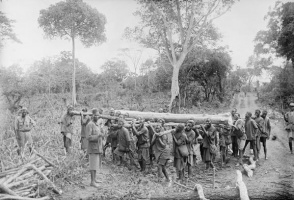Untold Deaths and Sufferings of ‘African Human Machines’ in World War One ( by Anozie Awambu)
Former
French President Nicolas Sarkozy stood on African soil in 2007 and bluntly
declared “the tragedy of Africa is that the African has not fully entered into
history”. Africans seethed at the insulting, many even believed racist, tone of
that speech. But as the world commemorated the centenary of the end of World War
One during last weekend, and as historians and the media recounted the many
sides of its history, I came to see that Sarkozy might even have been
generous.
Neither
the exceptional contributions of native Africans, nor their unique sufferings, in
that senseless conflict was even footnoted in any of the written commentaries
and TV documentaries that I reviewed. If you saw any, please let me know about
it.
Did
anyone mention that, apart from the thousands of Africans who died fighting as
enlisted soldiers for the various colonial (German, British, French, Belgian
and Portuguese) powers, an estimated 1.5 million African “labour corps” men, women and children
died in the frontlines of that war, on African soil? Did you hear that the last
battles of that war were fought on African soil, days after it had ended in
Europe?
If
the African must fully enter into history, us Africans must tell our story. Even if
not to counter an unfair narrative, at least to recognise the sufferings of our
forebearers. For “the past”, wrote
Chinua Achebe, “needs to be recreated not only for the enlightenment of our
detractors, but even for our own education”.
That is why I am taking out time this morning to pen this essay to
narrate the roles, deaths and sufferings of native Africans in Europe’s war,
that became World War 1.
Europe’s
military activities in Africa prior to WW1
Despite
the agreements at the Berlin Conference of 1884-85 that formalised and regulated
the Scramble and Partition of Africa, each European colonial power maintained a
two-pronged strategic programme in Africa: to expand its spheres of influence
and contain those of competing powers. At the same time, they worried about anti-imperialism
uprisings by the natives. To serve these
purposes, they established military commands in the colonies. For various
operational reasons they enlisted the natives into these garrisons. While these
armies never directly confronted one another, they carried out many operations to
suppress the natives whenever they tried to resist.
Nowhere
did this play out clearer than in British West Africa (present day Nigeria,
Ghana, Sierra Leone and Gambia). Towards the end of the 19th Century
the British were acutely concerned about French colonial expansion in
territories bordering Northern Nigeria. Around that same period, the Benin
Kingdom of Nigeria put up a resistance that could only bow to full military
offensive (the so-called Benin Expedition) in 1897 whereby British forces
stationed in South Africa in the aftermath of the First Boer War had to be
mobilised to Nigeria. The British colonial offices then saw the need to quickly
set up ready garrisons in different areas of West Africa. Colonel Fedrick Luggard was tasked in 1898 to
organise combat-ready, centrally-commanded, garrisons in all British West
Africa. Thus, the West African Volunteer Forces (WAFF) was born.
Numerous
locales were enlisted into WAFF, and these garrisons played a major role in containing the French, and in putting down various protests and uprisings by the locales.
Thus, was born in west Africa a toxic military doctrine which, till this day, leans
more towards the suppression of domestic dissent.
Similar doctrine and practice were adopted by the ‘Armee du Afrique’ in French North Africa (Morocco, Algeria and Tunisia), and in French West Africa (present Mauritania, Senegal, Mali, Guinea, Cote d'Ivoire, Burkina Faso and Benin, and Niger).
The
German Schutztruppe (Colonial Protection Troops) were probably the most brutal.
They were stationed in the German West African colonies of Kamerum and Togoland
( Togo and Cameroons), German South West
Africa (Namibia), and German East Africa (Burundi, Rwanda, and the mainland
part of Tanzania). Partly peopled by natives (known as the Askaris), the
Schutztruppe was later commanded by ruthless General Paul von Lettow-Vorbeck (nicknamed
the Lion of Africa), who led the most egregious crushing of native Africans
during the colonial era. He is believed to have shaped modern guerrilla
warfare. It was the Schutztruppe under
him which carried out the Herero and Namaqua Genocide of 1904-1908, in which
over 100,000 natives of German South-West Africa was exterminated. Historians
consider that murderous campaign the first genocide of the 20th
Century.
And
when in 1905 various tribes formed an alliance to wage the Maji-Maji Rebellion
in German East Africa (areas in present Tanzania), the Schutztruppe moved in.
To suppress the resolute resistance he met, Lettow-Vorbeck stepped
up his cruelty. He slaughtered men, women, children, babies, and livestock; set
ablaze houses and crop fields; and
poisoned water springs and streams. In that assault, over 250,000 Africans died
directly from physical violence, and many more died of famine afterwards. All this
in exchange of the Schutztruppe casualty of only 15 men. Yes, 15 men!
In
the Congo Free State (present DRC Congo, as at then officially a private
property of King Leopold of Belgium), the atrocities that the Force Publique (King Leopold’s army) committed
against the Congolese represent the worst cruelty meted out by any colonialist
during peace time. About 3,500 natives
were forcefully enlisted into the Force Publique. Among other things, officers of
this atrocious army cut off peoples’ arms and burnt human alive, just to
intimidate Africans to provide forced labour in rubber plantations.
All
said, before World War 1 broke out, European colonial powers had succeeded in whipping Africans to abject submission – a
phenomenon which would later help them to use Africans as human machines in the
ensuing World War 1.
African
Theatre of the War Develops
European
colonial powers reasoned that warring on African soil was
inimical to their colonial interests: Their colonies
had recently been acquired, were unstable, and operated through local structures.
If their small colonial armies fought one another, the locals could take
advantage and resist. So, part of the agreement
at the Berlin Conference was that the colonies would remain neutral if war
broke out at home in Europe.
As
the war broke out in 1914, these powers were committed to maintaining this neutrality
agreement.
But
Lettow-Vorbeck who by then had become the commander of the Schutztruppe had a
different calculus. Once the Allied Powers countries (Britain, France, Belgium,
and later Portugal) started to move troops back home to
join the combats in Europe, Lettow-Vorbeck decided to turn a strategic disadvantage to an advantage.
Germany’s
colonies in all African subregions were sandwiched between the colonies the
Allied Powers. Lettow-Vorbeck launched what
he termed ‘full offensives with no compromises’ against these nearby colonies,
destroying key critical infrastructure like bridges, railways, coaling stations,
wireless stations and mines. His objective?
To disrupt supplies of raw materials from Africa to the Allied Powers’
military industrial complexes in Europe, tie down troops who could return to
Europe, or possibly necessitate transfers of troops from Europe, thereby giving
Germany leverage in the European theatre. In these fulsome campaigns he overpowered the
numerically superior British and French colonial forces, battle after battle.
At
the same time the Germans had stepped up their sea commerce raids utilising
coaling and wireless stations in German South-West Africa. The Allied Powers had pressing impetus to
respond, with a strategic decision that most of their forces would comprise of locales.
Thus, the French, Belgian and the British Forces conscripted more local
personnel, co-ordinated amongst themselves and attacked the Schutztruppe.
By
end of 1916 they had captured German West Africa and German South-West Africa,
with only German East Africa left in the hands of Lettow-Verberck. With no more troops and supplies coming from
Germany, and now sandwiched in between advancing French, British, Belgian and
Portuguese forces on all sides, Lettow-Verbecks campaign had become an end unto
itself. But that ruthless General would perpetrate even more dastardly acts. He
resorted to brutal guerrilla assaults on enemy and natives’ locations stealing
equipment, food and any supplies, and torching whatever was left.
African Human Machines
Way
back during the campaigns against the various uprisings, the Schutztruppe had
been using non-combatants locales as slave labour. As the African theatre intensified,
this model would prove useful to the other powers.
The
African theatre, especially in East Africa, was a war of steady movements, short
bursts raids, and long treks. Yet the European powers did not have the luxury
of committing larger trained personnel due to dwindling manpower back home, and
the costs and logistical burdens of maintaining them. And unlike the European
theatre where the vegetation and presence of rail and road infrastructure
facilitated the movements of mechanised carriages to transport personnel and
supplies, African terrain was tougher and a clear opposite. The use of draught
animals (camels etc) for this purpose was hampered, firstly because the rains
rendered narrow forest paths impassable mud-pools for these beasts. But also considering
the high prevalence of trypanosomiasis (sleeping sickness) suffered by these
animals due to large presence of tsetse-flies.
The
colonialists’ solution to this problem was to create carrier and porter corps
who they practically used as machines. The British side initially called theirs
the Military Labour Bureau but later renamed it the Carrier Corps. Natives were
conscripted into this corps and subjected to inhuman physical burdens carrying
European trained soldiers, hardware equipment and supplies on their heads and
backs, making tortuous journeys in extreme climatic conditions through rugged terrains.
With no shoes, barely clothed, poorly fed, little-paid or sometimes unpaid at
all, these corps comprised of men, women and children. More than deaths from combats, most of them
died from malnutrition, diseases, and exhaustion from carrying heavy loads over
long distances.
Death Tool of the Carriers and Porters
The
exact death toll of the carriers and porters is not known till this day, mainly
because the colonial offices did not always keep records of the identities nor
numbers of people they recruited or into the corps, unlike they did with actual
soldiers.
The Germans did not bother to keep any records at all. On the British
side there exists fragments of records for some key battles. Some records put the number of Carrier Corps
deaths in East Africa fronts alone, to 95,000. That is more than thrice the number of all Canadian
and Australian troops who died fighting the same war.
Different
researches have arrived at different cumulative numbers. For example, records
of the British official historian of the war put the cumulative number of British
Carriers’ deaths to 200,000, with almost that number left ‘invalided’ (irreversibly
maimed). Other sources estimate that, all told, about 1.5 million Africans died
working as carriers and porters on all sides of the African theatre.
And
this does not include civilian casualties. Nor the estimated over 2 million
Africans who died of famine during and after that war which turned their crop
and grazing fields to battle grounds and decimated their workforce.
End of the Africa Battles
Signed
at about 5am (Paris time) on 11 November 1918, the treaty of Armistice agreed for
all hostilities to end at 11am on that day. The last shots in Europe were fired
about 10.57am, and at hostilities ended at the agreed time. But away in Africa things
still raged on. As of 13 November Lettow-Vorbeck launched a decisive
attack on the territory of British Rhodesia (present Zimbabwe). It was thereafter
that the British informed him of the Armistice treaty. But Lettow-Vorbeck did
not surrender, until two weeks later, on 25 November.
All
said, Europe’s brutal war ended on African soil.
Someday
Africa will arise to tell its story!



Comments
Post a Comment